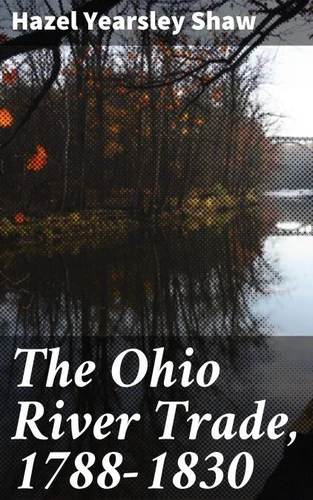The Ohio River Trade, 1788 - 1830. Navigating the Currents of Early American Trade
Par :Formats :
Disponible dans votre compte client Decitre ou Furet du Nord dès validation de votre commande. Le format ePub est :
- Compatible avec une lecture sur My Vivlio (smartphone, tablette, ordinateur)
- Compatible avec une lecture sur liseuses Vivlio
- Pour les liseuses autres que Vivlio, vous devez utiliser le logiciel Adobe Digital Edition. Non compatible avec la lecture sur les liseuses Kindle, Remarkable et Sony
 , qui est-ce ?
, qui est-ce ?Notre partenaire de plateforme de lecture numérique où vous retrouverez l'ensemble de vos ebooks gratuitement
Pour en savoir plus sur nos ebooks, consultez notre aide en ligne ici
- Nombre de pages87
- FormatePub
- ISBN406-4-06-618387-5
- EAN4064066183875
- Date de parution19/05/2021
- Protection num.Digital Watermarking
- Taille671 Ko
- Infos supplémentairesepub
- ÉditeurGOOD PRESS
Résumé
In "The Ohio River Trade, 1788-1830, " Hazel Yearsley Shaw provides a meticulous examination of the economic and cultural dynamics surrounding the Ohio River trade during a pivotal era in American history. Shaw employs a blend of narrative non-fiction and critical analysis, utilizing primary sources such as merchant accounts, diaries, and governmental records to paint a vivid picture of the river as a conduit for commerce and cultural exchange.
The work is deeply contextualized within the broader scope of early American development, illustrating how the trade network facilitated not only economic prosperity but also migration, settler colonialism, and the eventual rise of the Midwest as an integral part of the nation'Äôs fabric. Shaw'Äôs background as a historian with expertise in transportation and trade in early America informs her nuanced narrative.
With a Ph. D. focused on American economic history, Shaw has dedicated her career to bridging gaps in historical knowledge concerning the Midwest and the Ohio River region specifically. Her extensive research in both archival repositories and historical societies underscores her commitment to revealing overlooked aspects of American economic history. This book is essential for historians, economists, and general readers alike who seek to understand the complexities of early American trade and its lasting implications.
Shaw'Äôs engaging prose and thorough research make this a compelling read for anyone interested in the interconnections of geography, economy, and society in shaping the United States.
The work is deeply contextualized within the broader scope of early American development, illustrating how the trade network facilitated not only economic prosperity but also migration, settler colonialism, and the eventual rise of the Midwest as an integral part of the nation'Äôs fabric. Shaw'Äôs background as a historian with expertise in transportation and trade in early America informs her nuanced narrative.
With a Ph. D. focused on American economic history, Shaw has dedicated her career to bridging gaps in historical knowledge concerning the Midwest and the Ohio River region specifically. Her extensive research in both archival repositories and historical societies underscores her commitment to revealing overlooked aspects of American economic history. This book is essential for historians, economists, and general readers alike who seek to understand the complexities of early American trade and its lasting implications.
Shaw'Äôs engaging prose and thorough research make this a compelling read for anyone interested in the interconnections of geography, economy, and society in shaping the United States.
In "The Ohio River Trade, 1788-1830, " Hazel Yearsley Shaw provides a meticulous examination of the economic and cultural dynamics surrounding the Ohio River trade during a pivotal era in American history. Shaw employs a blend of narrative non-fiction and critical analysis, utilizing primary sources such as merchant accounts, diaries, and governmental records to paint a vivid picture of the river as a conduit for commerce and cultural exchange.
The work is deeply contextualized within the broader scope of early American development, illustrating how the trade network facilitated not only economic prosperity but also migration, settler colonialism, and the eventual rise of the Midwest as an integral part of the nation'Äôs fabric. Shaw'Äôs background as a historian with expertise in transportation and trade in early America informs her nuanced narrative.
With a Ph. D. focused on American economic history, Shaw has dedicated her career to bridging gaps in historical knowledge concerning the Midwest and the Ohio River region specifically. Her extensive research in both archival repositories and historical societies underscores her commitment to revealing overlooked aspects of American economic history. This book is essential for historians, economists, and general readers alike who seek to understand the complexities of early American trade and its lasting implications.
Shaw'Äôs engaging prose and thorough research make this a compelling read for anyone interested in the interconnections of geography, economy, and society in shaping the United States.
The work is deeply contextualized within the broader scope of early American development, illustrating how the trade network facilitated not only economic prosperity but also migration, settler colonialism, and the eventual rise of the Midwest as an integral part of the nation'Äôs fabric. Shaw'Äôs background as a historian with expertise in transportation and trade in early America informs her nuanced narrative.
With a Ph. D. focused on American economic history, Shaw has dedicated her career to bridging gaps in historical knowledge concerning the Midwest and the Ohio River region specifically. Her extensive research in both archival repositories and historical societies underscores her commitment to revealing overlooked aspects of American economic history. This book is essential for historians, economists, and general readers alike who seek to understand the complexities of early American trade and its lasting implications.
Shaw'Äôs engaging prose and thorough research make this a compelling read for anyone interested in the interconnections of geography, economy, and society in shaping the United States.



